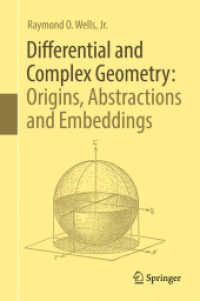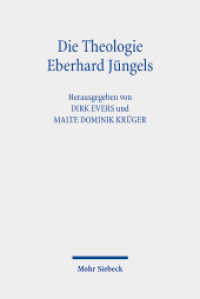- ホーム
- > 洋書
- > 英文書
- > Politics / International Relations
Full Description
This book explores a striking common feature of pre-modern ruling systems on a global scale: the participation of childless and celibate men as integral parts of the elites. In bringing court eunuchs and bishops together, this collection shows that the integration of men who were normatively or physically excluded from biological fatherhood offered pre-modern dynasties the potential to use different reproduction patterns. The shared focus on ruling eunuchs and bishops also reveals that these men had a specific position at the intersection of four fields: power, social dynamics, sacredness and gender/masculinities. The thirteen chapters present case studies on clerics in Medieval Europe and court eunuchs in the Middle East, Byzantium, India and China. They analyze how these men in their different frameworks acted as politicians, participated in social networks, provided religious authority, and discuss their masculinities. Taken together, this collection sheds light on the political arena before the modern nation-state excluded these unmarried men from the circles of political power.
Contents
Introduction: Celibate and Childless Men Placed into a Shared Focus: Ruling Eunuchs and Bishops Between the Intersections of Power, Networks, Sacredness and Gender
[Almut Höfert]
Part 1: Bishops and Eunuchs as Parts of the Ruling Elites
1. The Bishop in the Latin West 600-1100
[Julia Barrow]
2. Guarding the Harem, Protecting the State: Eunuchs in a Fourth/Tenth Century ʿAbbasid Court
[Nadia Maria El Cheikh]
3. Muʾnis al-Muẓaffar: An Exceptional Eunuch
[Hugh Kennedy]
4. Harem and Eunuchs: Liminality and Networks of Mughal Authority
[Ruby Lal]
Part 2: Networks and Kinships
5. Celibate, But Not Childless: Eunuch Military Dynasticism in Medieval China
[Michael Hoeckelmann]
6. Spiritual Heirs and Families: Episcopal Relatives in Early Medieval Francia
[Rachel Stone]
7. Eunuchs and the East India Company in North India
[Jessica Hinchy]
Part 3: Religious Authority and Sacredness
8. Physical and Symbolic Castration and the Holy Eunuch in Late Antiquity, Third to Sixth Centuries CE
[Mathew Kuefler]
9. Monastic Superiority, Episcopal Authority and Masculinity in Caesarius of Heisterbach's Dialogus Miraculorum
[Matthew M. Mesley]
10. The Chief Harem Eunuch of the Ottoman Empire: Servant of the Sultan, Servant of the Prophet
[Jane Hathaway]
Part 4: Gender and Masculinities
11. Byzantine Court Eunuchs and the Macedonian Dynastie (867-1056): Family, Power and Gender
[Shaun Tougher]
12. Eunuchs in the Fatimid Empire: Ambiguities, Gender and Sacredness
[Serena Tolino]








